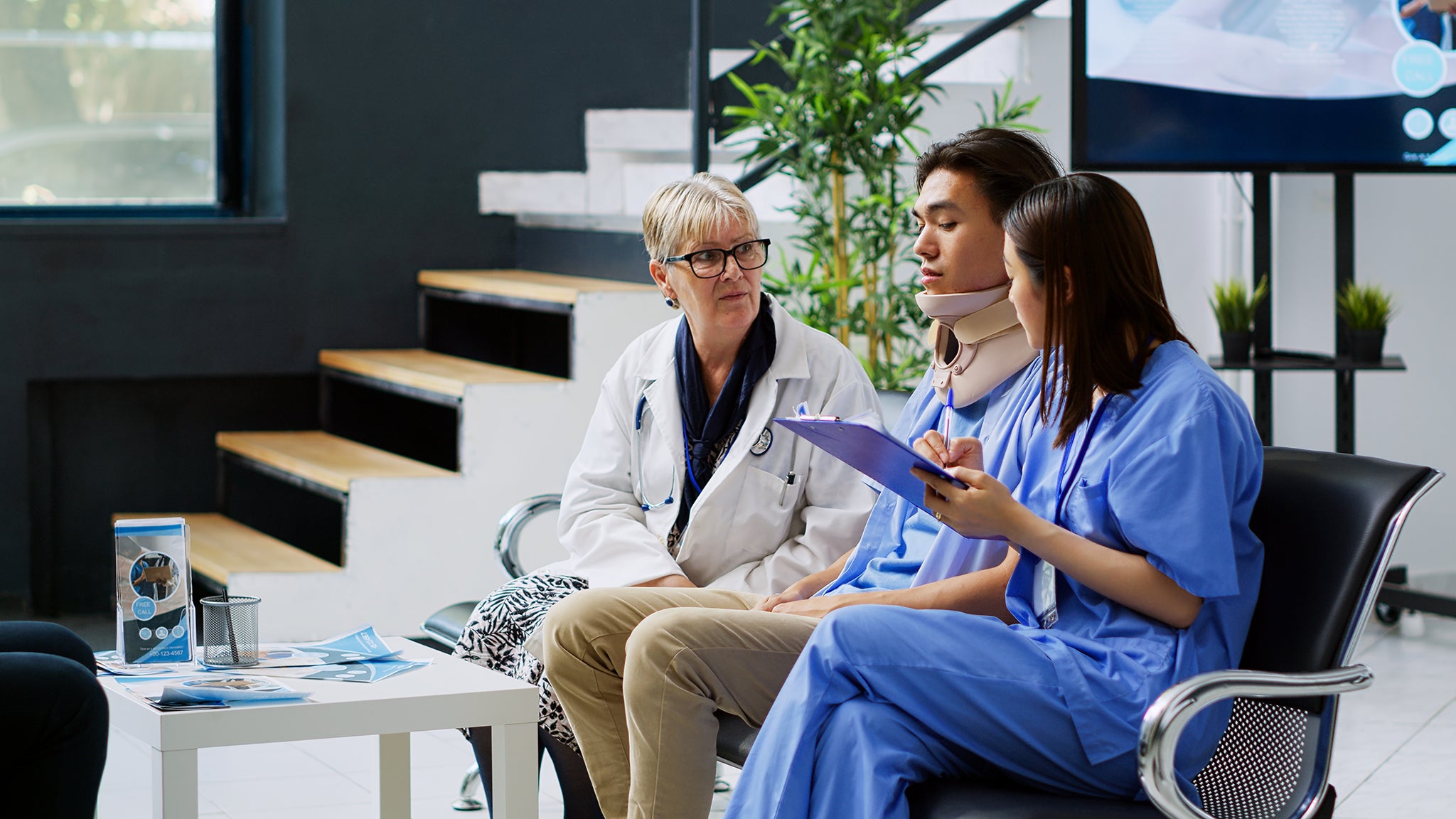What are clinical observations?
The critical role of effective clinical observations in UK healthcare settings
By Dr Richard Dune

Image by DragonImages via Envato Elements
In the fast-paced healthcare environment, the ability to perform effective clinical observations is not just a skill but a necessity. These observations serve as the cornerstone for patient care, influencing decisions from diagnosis to treatment and recovery.
In this blog, Dr Richard Dune delves into the importance of clinical observations within UK healthcare settings, underscoring their significance through key facts and statistics, definitions, legislation, and best practices.
What are clinical observations?
The critical role of effective clinical observations in UK healthcare settings
By Dr Richard Dune

Image by DragonImages via Envato Elements
In the fast-paced healthcare environment, the ability to perform effective clinical observations is not just a skill but a necessity. These observations serve as the cornerstone for patient care, influencing decisions from diagnosis to treatment and recovery.
In this blog, Dr Richard Dune delves into the importance of clinical observations within UK healthcare settings, underscoring their significance through key facts and statistics, definitions, legislation, and best practices.

Image by monkeybusiness Envato Elements
The significance of clinical observations
Clinical observations are the first line of defence in patient care, enabling healthcare professionals to detect early signs of deterioration or improvement. According to the National Institute for Health and Care Excellence (NICE), timely and accurate clinical observations can significantly reduce patient morbidity and mortality rates.
These vital checks - including measurements of temperature, pulse, blood pressure, respiratory rate, and oxygen saturation - are critical for assessing a patient's health status and responding to emergencies.
Key definitions related to clinical observations
- Vital signs - Measurements that indicate the state of a patient's critical bodily functions.
- Early Warning Score (EWS) - A predictive tool used to identify patients at risk of deteriorating.
Understanding these terms is crucial for healthcare professionals to monitor and interpret patient data, ensuring high-quality care effectively.

Image by DC_Studio via Envato Elements

Image by gstockstudio via Envato Elements
What are the clinical observations?
Clinical observations refer to the routine monitoring and recording of a patient's vital signs to assess their current health status. These observations are crucial in detecting early signs of deterioration or improvement in a patient's condition.
Key clinical observations include temperature, heart rate, blood pressure, respiratory rate, oxygen saturation and pain management.
Let’s discuss these vital signs in more detail below.
Temperature
Measurement of the body's internal heat, indicating infection, inflammation, or other health conditions.
Pulse rate (heart rate)
The number of heartbeats per minute, provides insights into heart function and overall cardiovascular health.
Blood pressure
The force of blood against artery walls during and between heartbeats, indicating cardiovascular health and risk of conditions such as hypertension.
Respiratory rate
The number of breaths taken per minute is essential for assessing lung and overall respiratory health.
Oxygen saturation (SpO2)
The percentage of oxygen in the blood, is critical for ensuring tissues receive enough oxygen to function properly.
Pain
Often considered the "fifth vital sign," involves assessing the patient's pain level to manage and address pain effectively.
These observations guide clinical decisions, including diagnosing conditions, monitoring a disease's progression, and evaluating treatments' effectiveness. Regular and accurate clinical observations ensure timely interventions and promote patient safety and recovery.
Legislative framework and best practices
In the UK, clinical observations are governed by a robust legislative framework, including the Health and Social Care Act 2008, which emphasises the need for safe and effective care. The Care Quality Commission (CQC) mandates regular and accurate clinical observations to ensure health and safety standards compliance.
Best practices outlined by NICE and the Royal College of Nursing (RCN) recommend regular training and adherence to clinical guidelines to maintain the competency of healthcare professionals.

Image by nd3000 via Envato Elements

Image by Wavebreakmedia via Envato Elements
The role of effective clinical observations
Early detection and intervention
Effective clinical observations allow for the early detection of potential health issues, facilitating timely intervention and reducing the likelihood of adverse outcomes.
Enhancing patient safety
By closely monitoring patients, healthcare professionals can ensure patient safety, identifying and mitigating risks before they escalate into serious problems.
Informing clinical decisions
Accurate and timely observations provide a solid foundation for clinical decisions, from initiating treatment to adjusting care plans.
Compliance and quality of care
Adhering to the standards set by regulatory bodies through effective observations ensures high-quality care and compliance with national healthcare regulations.
Implementing best practices
Regular training
Continuous education and training on the latest clinical observation techniques and guidelines are essential.
Technology integration
Leveraging technology can enhance the accuracy and efficiency of clinical observations.
Policy development
Developing clear policies and procedures aligned with the latest legislation and best practices ensures consistency and compliance.
Patient-centred approach
Tailoring clinical observations to meet patients' individual needs promotes a more compassionate and effective care environment.

Image by seventyfourimages via Envato Elements

Image by DC_Studio via Envato Elements
Recommendations for care providers
Embrace continuous learning
Engage in regular training and education to stay updated on the best practices and latest developments in clinical observations.
Adopt technology
Utilise technological solutions to streamline training processes and improve the accuracy of clinical observations.
Foster a culture of excellence
Encourage a culture of excellence and accountability within healthcare teams, emphasising the importance of clinical observations in patient care.
Ensure compliance
Regularly review and update practices to meet the legal and regulatory requirements set forth by the CQC and other governing bodies.
Conclusion
Effective clinical observations are indispensable in the landscape of UK healthcare, directly impacting patient outcomes and the quality of care. By understanding and implementing the key definitions, adhering to legislative frameworks and best practices, and embracing continuous improvement and technological advancements, healthcare professionals can ensure they are providing the safest and most effective care possible.

Image by mstandret via Envato Elements
Enhance your clinical skills through ComplyPlus LMS™
Further enhance your skills and knowledge in clinical observations by exploring the comprehensive range of accredited courses available on ComplyPlus LMS™. Stay ahead in your practice, ensure the best patient outcomes, and comply with the latest healthcare standards.
Sign up here.The significance of clinical observations

Image by monkeybusiness Envato Elements
Clinical observations are the first line of defence in patient care, enabling healthcare professionals to detect early signs of deterioration or improvement. According to the National Institute for Health and Care Excellence (NICE), timely and accurate clinical observations can significantly reduce patient morbidity and mortality rates.
These vital checks - including measurements of temperature, pulse, blood pressure, respiratory rate, and oxygen saturation - are critical for assessing a patient's health status and responding to emergencies.
Key definitions related to clinical observations

Image by DC_Studio via Envato Elements
- Vital signs - Measurements that indicate the state of a patient's critical bodily functions.
- Early Warning Score (EWS) - A predictive tool used to identify patients at risk of deteriorating.
Understanding these terms is crucial for healthcare professionals to monitor and interpret patient data, ensuring high-quality care effectively.
What are the clinical observations?

Image by gstockstudio via Envato Elements
Clinical observations refer to the routine monitoring and recording of a patient's vital signs to assess their current health status. These observations are crucial in detecting early signs of deterioration or improvement in a patient's condition.
Key clinical observations include temperature, heart rate, blood pressure, respiratory rate, oxygen saturation and pain management.
Let’s discuss these vital signs in more detail below.
Temperature
Measurement of the body's internal heat, indicating infection, inflammation, or other health conditions.
Pulse rate (heart rate)
The number of heartbeats per minute, provides insights into heart function and overall cardiovascular health.
Blood pressure
The force of blood against artery walls during and between heartbeats, indicating cardiovascular health and risk of conditions such as hypertension.
Respiratory rate
The number of breaths taken per minute is essential for assessing lung and overall respiratory health.
Oxygen saturation (SpO2)
The percentage of oxygen in the blood, is critical for ensuring tissues receive enough oxygen to function properly.
Pain
Often considered the "fifth vital sign," involves assessing the patient's pain level to manage and address pain effectively.
These observations guide clinical decisions, including diagnosing conditions, monitoring a disease's progression, and evaluating treatments' effectiveness. Regular and accurate clinical observations ensure timely interventions and promote patient safety and recovery.
Legislative framework and best practices

Image by nd3000 via Envato Elements
In the UK, clinical observations are governed by a robust legislative framework, including the Health and Social Care Act 2008, which emphasises the need for safe and effective care. The Care Quality Commission (CQC) mandates regular and accurate clinical observations to ensure health and safety standards compliance.
Best practices outlined by NICE and the Royal College of Nursing (RCN) recommend regular training and adherence to clinical guidelines to maintain the competency of healthcare professionals.
The role of effective clinical observations

Image by Wavebreakmedia via Envato Elements
Early detection and intervention
Effective clinical observations allow for the early detection of potential health issues, facilitating timely intervention and reducing the likelihood of adverse outcomes.
Enhancing patient safety
By closely monitoring patients, healthcare professionals can ensure patient safety, identifying and mitigating risks before they escalate into serious problems.
Informing clinical decisions
Accurate and timely observations provide a solid foundation for clinical decisions, from initiating treatment to adjusting care plans.
Compliance and quality of care
Adhering to the standards set by regulatory bodies through effective observations ensures high-quality care and compliance with national healthcare regulations.
Implementing best practices

Image by seventyfourimages via Envato Elements
Regular training
Continuous education and training on the latest clinical observation techniques and guidelines are essential.
Technology integration
Leveraging technology can enhance the accuracy and efficiency of clinical observations.
Policy development
Developing clear policies and procedures aligned with the latest legislation and best practices ensures consistency and compliance.
Patient-centred approach
Tailoring clinical observations to meet patients' individual needs promotes a more compassionate and effective care environment.
Recommendations for care providers

Image by DC_Studio via Envato Elements
Embrace continuous learning
Engage in regular training and education to stay updated on the best practices and latest developments in clinical observations.
Adopt technology
Utilise technological solutions to streamline training processes and improve the accuracy of clinical observations.
Foster a culture of excellence
Encourage a culture of excellence and accountability within healthcare teams, emphasising the importance of clinical observations in patient care.
Ensure compliance
Regularly review and update practices to meet the legal and regulatory requirements set forth by the CQC and other governing bodies.
Conclusion

Image by mstandret via Envato Elements
Effective clinical observations are indispensable in the landscape of UK healthcare, directly impacting patient outcomes and the quality of care. By understanding and implementing the key definitions, adhering to legislative frameworks and best practices, and embracing continuous improvement and technological advancements, healthcare professionals can ensure they are providing the safest and most effective care possible.
Enhance your clinical skills through ComplyPlus LMS™
Further enhance your skills and knowledge in clinical observations by exploring the comprehensive range of accredited courses available on ComplyPlus LMS™. Stay ahead in your practice, ensure the best patient outcomes, and comply with the latest healthcare standards.
Sign up here.Related blog articles
View all
Clinical effectiveness and clinical governance: An introduction

References and resources
National Library of Medicine (2023) - Vital Sign Assessment - StatPearls - NCBI Bookshelf.
National Library of Medicine (2020) - The power of observation in clinical medicine - PMC.
Springer Link (2021) - The effect of self-practicing systematic clinical observations in a multiplayer, immersive, interactive virtual reality application versus physical equipment: a randomised controlled trial | Advances in Health Sciences Education.
Europe PMC (2020) - Vital Sign Assessment - Abstract - Europe PMC.
References and resources

National Library of Medicine (2023) - Vital Sign Assessment - StatPearls - NCBI Bookshelf.
National Library of Medicine (2020) - The power of observation in clinical medicine - PMC.
Springer Link (2021) - The effect of self-practicing systematic clinical observations in a multiplayer, immersive, interactive virtual reality application versus physical equipment: a randomised controlled trial | Advances in Health Sciences Education.
Europe PMC (2020) - Vital Sign Assessment - Abstract - Europe PMC.
About Dr Richard Dune
Dr Richard Dune is a leading health and social care governance expert. Throughout his career, he has worked in various settings across the UK, including NHS Trusts, research and development, academic institutions, and private companies.
His work primarily focuses on developing, deploying and evaluating technologies, such as clinical decision support systems, educational technologies, workforce development and regulatory compliance solutions.
Dr Dune regularly writes about topical issues affecting the UK's health and social care sectors. Additionally, he speaks at conferences, stakeholder workshops, and professional forums. Dr Dune is also a research fellow at University Hospitals Coventry and Warwickshire in the Research, Development and Innovation department. His other passions include content development, education, and coaching. Click here to read more articles by Dr Dune.

About Dr Richard Dune
Dr Richard Dune is a leading health and social care governance expert. Throughout his career, he has worked in various settings across the UK, including NHS Trusts, research and development, academic institutions, and private companies.
His work primarily focuses on developing, deploying and evaluating technologies, such as clinical decision support systems, educational technologies, workforce development and regulatory compliance solutions.
Dr Dune regularly writes about topical issues affecting the UK's health and social care sectors. Additionally, he speaks at conferences, stakeholder workshops, and professional forums. Dr Dune is also a research fellow at University Hospitals Coventry and Warwickshire in the Research, Development and Innovation department. His other passions include content development, education, and coaching. Click here to read more articles by Dr Dune.

Contact us
Complete the form below to find out how we can help your organisation with regulatory compliance and governance, statutory and mandatory training, continuous professional development, learning management systems and educational technologies.



